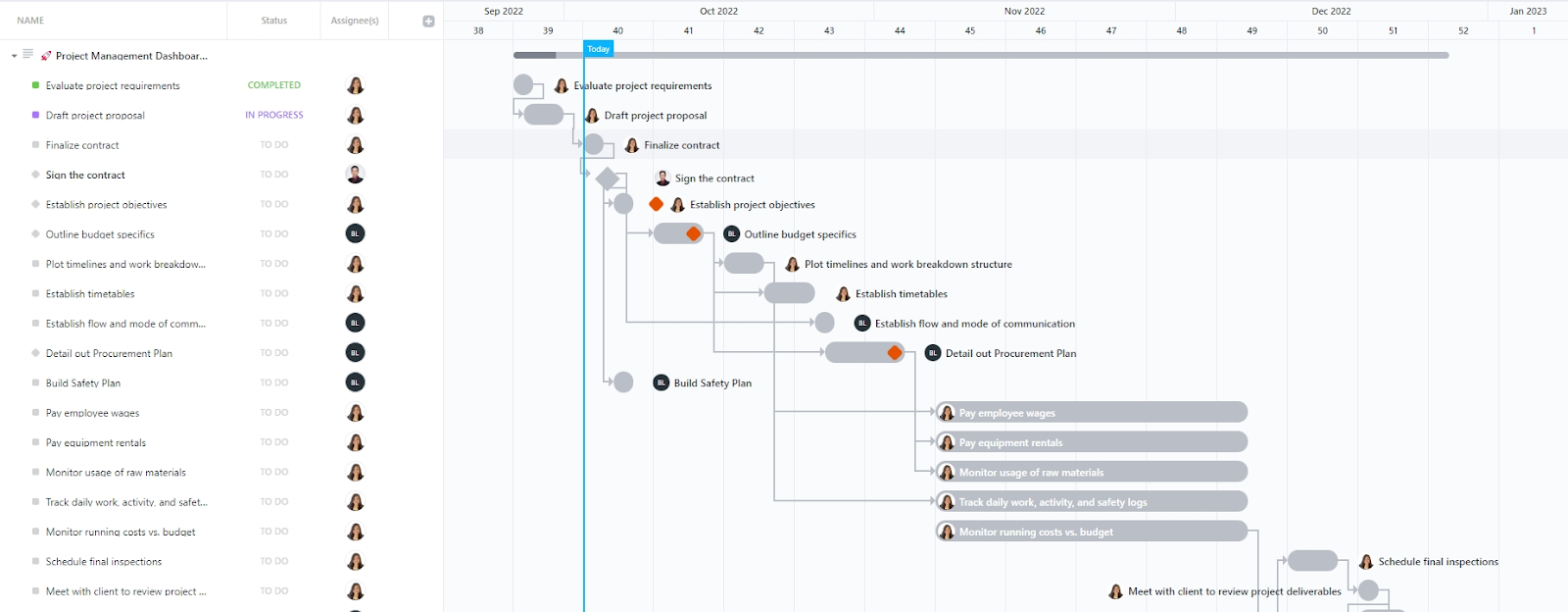هل تتذكر مشروع المجموعة في المدرسة حيث لم يكن أحد يعرف من يقوم بماذا؟
بالانتقال سريعًا إلى يومنا هذا: لم يتغير الكثير.
على الرغم من أن 77% من فرق المشاريع الناجحة تستخدم أدوات إدارة المشاريع، لا يزال الكثيرون يغرقون في المعلومات المتناثرة والأولويات غير الواضحة.
هنا يمكن أن تساعدك إدارة المشاريع البصرية: لأن دماغك يعالج الصور بسرعة تزيد 60,000 مرة عن النصوص.
لا عجب أن أعيننا تضيء عند رؤية المخططات الدائرية واللوحات الملونة، مثلما تضيء عيون جوي عند رؤية البيتزا.
سيوضح لك هذا المدونة كيفية تحويل المشاريع الفوضوية إلى سير عمل واضح وتعاوني باستخدام أدوات تصور البيانات التي سيستمتع فريقك باستخدامها (نعم، حتى ذلك الشخص من قسم المالية).
هل أنت مستعد لرؤية الصورة الكبيرة - بالمعنى الحرفي للكلمة؟
ما هي إدارة المشاريع المرئية؟
إدارة المشاريع المرئية هي نهج حديث لإدارة المشاريع يستخدم أدوات مرئية، مثل اللوحات والرس وم البيانية والمخططات والجداول الزمنية، لمساعدة الفرق على تصور الأولويات وتتبع التقدم المحرز واتخاذ قرارات أسرع وأكثر استنارة.
من خلال تحويل بيانات المشاريع المعقدة إلى عناصر مرئية سهلة القراءة، تظل الفرق متوافقة، وتحدد العقبات في وقت مبكر، وتزيد من فرص نجاح المشروع.
1. رؤية سير العمل بوضوح: استخدم أدوات إدارة المهام المرئية لتقسيم العمل إلى مكونات مرئية واضحة (مثل لوحات Kanban أو مخططات Gantt)
2. تحديثات حالة المشروع في الوقت الفعلي: اطلع على حالة المشروع الحالية في لمحة سريعة دون الحاجة إلى البحث في جداول البيانات أو سلاسل الرسائل الإلكترونية الطويلة.
3. الأولويات التي يمكنك رؤيتها: استخدم الإشارات المرئية مثل الترميز اللوني والملصقات وأشرطة التقدم لتصور الأولويات والتركيز على ما هو أكثر أهمية.
4. رؤى مستندة إلى البيانات: حوّل البيانات الأولية للمشروع إلى لوحات معلومات ومخططات بيانية توفر رؤى حول أداء الفريق والمواعيد النهائية وحجم العمل.
5. تعزيز نجاح المشاريع: حسّن الوضوح والتعاون، مما يؤدي في النهاية إلى سير عمل أكثر سلاسة، ومفاجآت أقل، ونجاح أكثر اتساقًا للمشاريع.
🧠 حقيقة ممتعة: من المرجح أن أول أداة لإدارة المشاريع بصريًا كانت عبارة عن حائط مليء بالملاحظات اللاصقة. أدى الاختراع العرضي للملاحظات اللاصقة من قبل علماء 3M سبنسر سيلفر وآرت فراي في السبعينيات إلى ثورة في طريقة قيام الفرق بالعصف الذهني وتنظيم المهام بصريًا. أصبحت هذه الملاحظات البسيطة أدوات لا غنى عنها لتصور سير العمل والتعاون بفعالية.
📖 اقرأ أيضًا: أفضل أدوات الذكاء الاصطناعي لتصور البيانات
لماذا تستخدم إدارة المشاريع المرئية؟
تتحرك الفرق اليوم بسرعة، والوضوح أمر لا يقبل التفاوض. تساعد إدارة المشاريع المرئية على تبسيط التعقيدات من خلال تحويل البيانات إلى تنسيقات سهلة الفهم. باستخدام الأدوات المرئية المناسبة، يمكن للفرق التركيز على ما هو أكثر أهمية: التعاون والمساءلة والنتائج.
بعض الأسباب لاستخدام إدارة المشاريع المرئية:
- عزز الوضوح باستخدام لوحات المعلومات ومخططات إدارة المشاريع
- تتبع تقدم المشروع في كل مرحلة باستخدام لوحات تفاعلية في الوقت الفعلي
- حسّن إدارة الموارد من خلال تحديد الاختناقات وإعادة التخصيص بسرعة
- حافظ على تركيزك على النتائج المطلوبة من خلال مواءمة العمل مع مؤشرات الأداء الرئيسية
- اتخذ قرارات أفضل من خلال رؤية الصورة الكاملة في عرض مركزي واحد
💡 نصيحة احترافية: هل تريد الارتقاء بإدارة المشاريع إلى المستوى التالي؟ جرب ميزات الذكاء الاصطناعي الجديدة في ClickUp مثل AI Assign و AI Prioritize و AI Cards. لا داعي لمتابعة المهام بعد الآن!
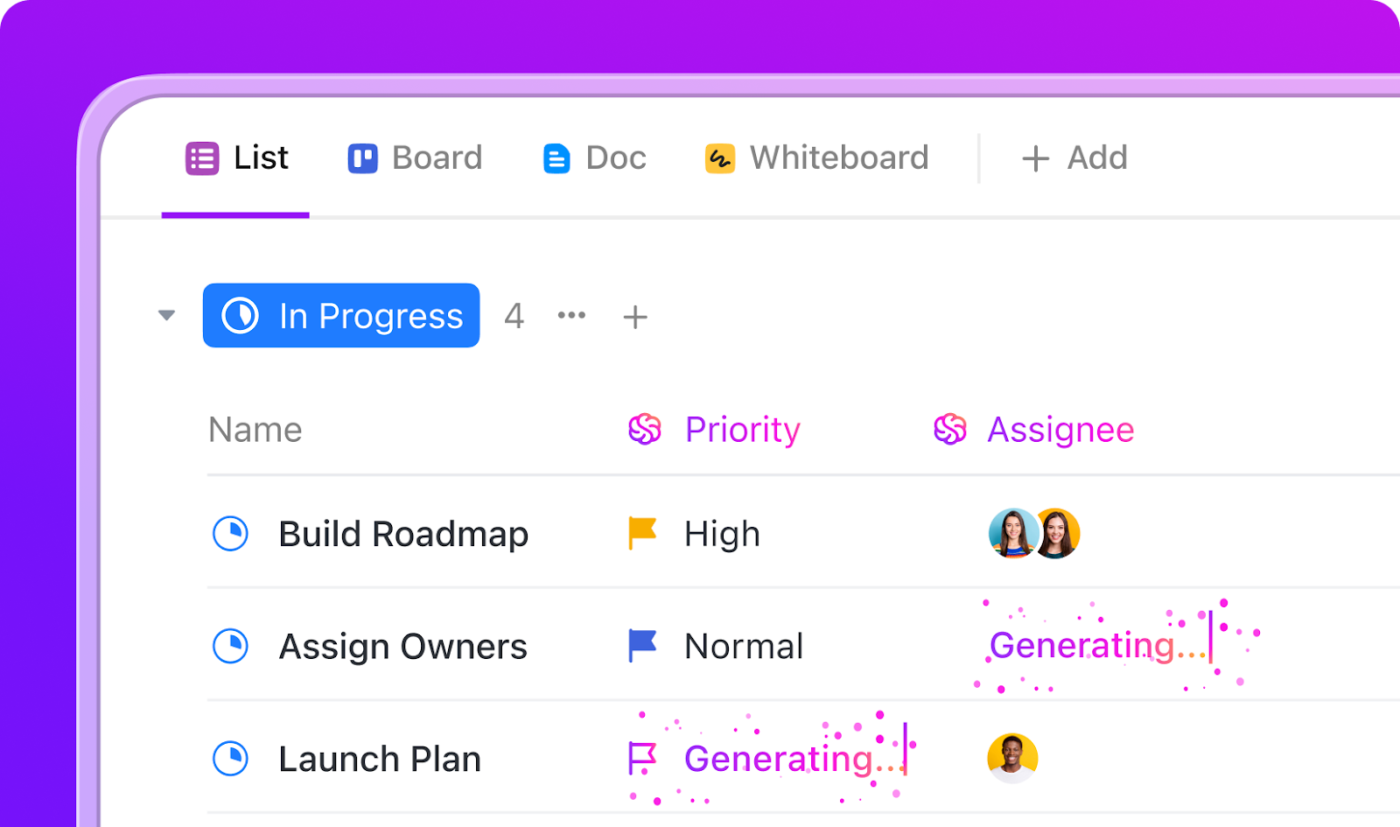
📖 اقرأ أيضًا: كيفية إنشاء رسم بياني أو مخطط خطي في جداول بيانات Google
أمثلة على أدوات إدارة المشاريع المرئية الشائعة
عند اختيار أدوات التمثيل المرئي للمشاريع، تحتاج إلى خيارات تتناسب مع سير عملك. فيما يلي نظرة متعمقة على حلول الإدارة المرئية الأكثر فعالية، مدعومة ببيانات المستخدمين الحقيقية والتطبيقات العملية.
1. لوحات كانبان

تُظهر لوحات Kanban تقدم المهام من خلال أعمدة مثل "المهام المطلوب تنفيذها" و"قيد التنفيذ" و"تم تنفيذها". وهي مثالية لتعزيز التعاون بين أعضاء الفريق وتقديم تحديثات سريعة عن حالة المهام.
يساعد نظام البطاقات الخاص به على تتبع المهام باستخدام ملصقات ملونة لتحديد الأولويات.
غالبًا ما تستخدمه فرق التسويق في جداول المحتوى، بينما تعتمد عليه فرق البرمجيات في تتبع الأخطاء.
يمكن أن يساعدك ClickUp Brain، المساعد الذكي المدمج في ClickUp، في إنشاء لوحات كانبان من الصفر! (دون الحاجة إلى التفكير 👀)
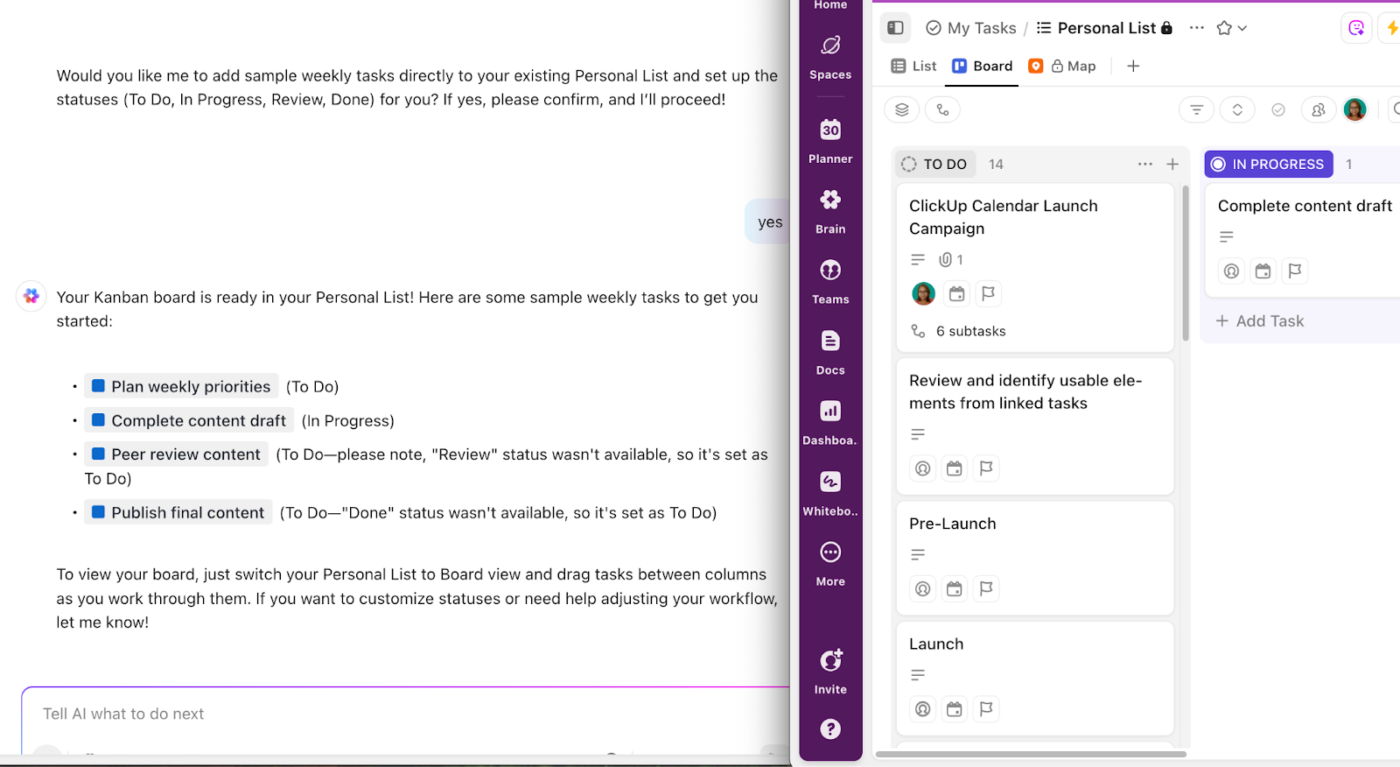
📖 اقرأ أيضًا: قوالب لوحة كانبان مجانية في OneNote و ClickUp
2. مخططات جانت

يضع مخطط جانت المهام على جدول زمني للمشاريع المعقدة التي تتضمن العديد من الأجزاء المتحركة. ويساعد ذلك في تخطيط المشاريع من خلال عرض:
- تواريخ بدء المهام وانتهائها
- كيف تعتمد الأعمال المختلفة على بعضها البعض
- من المسؤول عن كل مهمة
- الجدول الزمني العام للمشروع والمراحل الرئيسية
💡 نصيحة احترافية: عند استخدام برنامج إدارة المشاريع المرئية للوحات Kanban أو مخططات Gantt، لا تكتفِ بتصور المهام فحسب، بل تصور العوائق أيضًا. أنشئ عمودًا محددًا بعنوان "معطل" أو "يحتاج إلى مراجعة" وقم بتعيين علامات مرئية (مثل العلامات الحمراء أو أيقونات التحذير) لإبراز الأماكن التي تعطلت فيها الأمور. يمنح هذا فريقك رؤية فورية وقابلة للتنفيذ لما يؤخر التقدم، وليس فقط ما يسير على الطريق الصحيح.
3. السبورات البيضاء
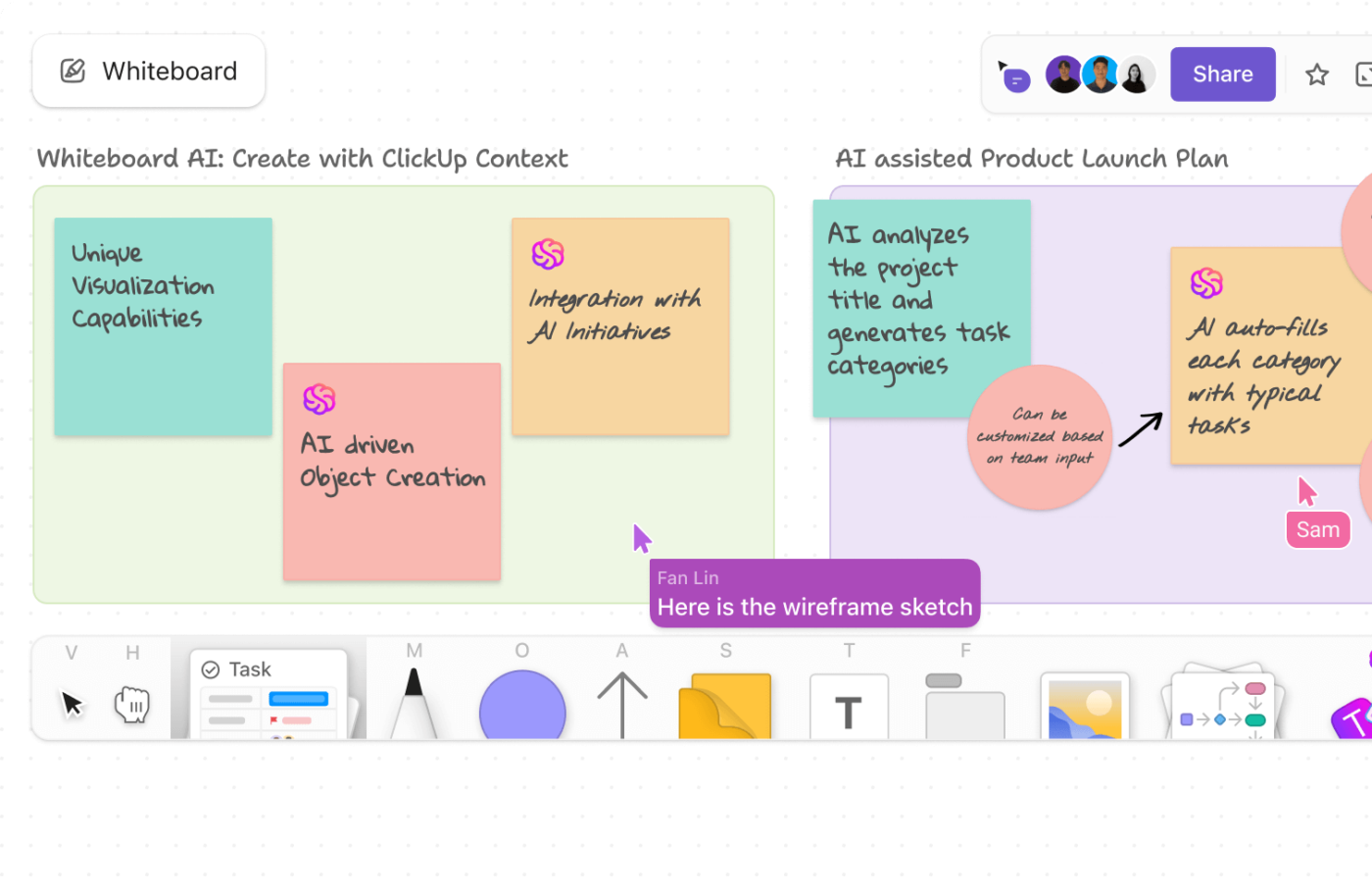
توفر اللوحات البيضاء للفرق مساحة مشتركة للعصف الذهني والتخطيط.
يمكن لفريقك رسم الأفكار وإنشاء سير العمل وتحويل المفاهيم إلى مهام قابلة للتنفيذ — وهو أمر مثالي عندما تحتاج إلى تعاون جماعي يشبه العمل معًا بشكل شخصي.
💟 نصيحة إضافية: هل تريد الارتقاء بمهاراتك في إدارة المشاريع إلى المستوى التالي؟ جرب الجمع بين عرض حجم العمل وعرض الخريطة في ClickUp للحصول على نهج قوي وشامل. تخيل أنك تدير وكالة لديها العديد من العملاء ومواعيد نهائية ضيقة — يتيح لك عرض حجم العمل تحديد من يعاني من عبء عمل زائد على الفور وإعادة توازن المهام بسهولة، حتى لا يتعرض أي شخص للإرهاق خلال أوقات الذروة.
وفي الوقت نفسه، إذا كنت تدير فريقًا ميدانيًا أو تخطط لأحداث أو تنسق زيارات مبيعات، فإن عرض الخريطة يوفر لك تخطيطًا مرئيًا لمكان تنفيذ كل مهمة. باستخدام كلا العرضين معًا، لن تحافظ فقط على توازن عبء العمل لفريقك، بل ستتخذ أيضًا قرارات أكثر ذكاءً تستند إلى الموقع، مما يعزز الكفاءة ويجعل الجميع سعداء.
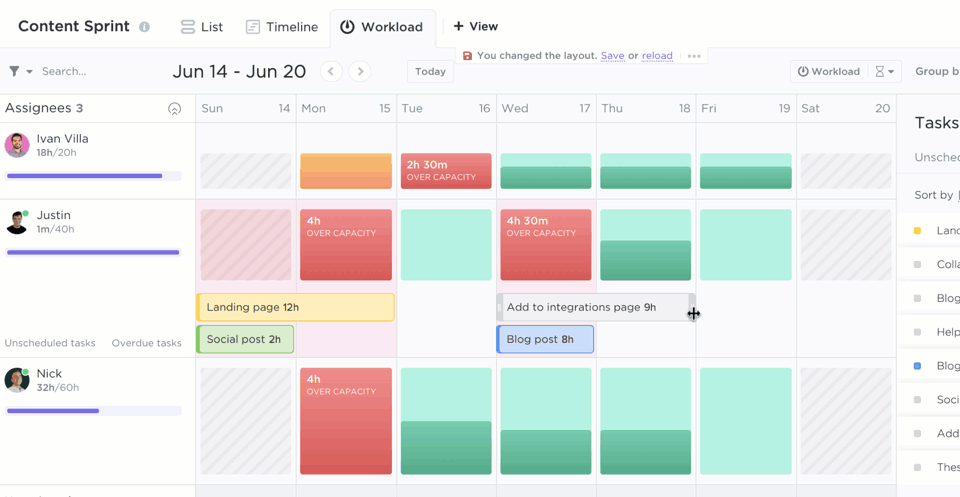
4. لوحات المعلومات

فكر في إدارة المشاريع كقيادة السيارة — فأنت بحاجة إلى رؤية واضحة للطريق أمامك لتبقى على المسار الصحيح.
لوحة المعلومات هي مساحة عمل مرئية تجمع جميع بيانات مشروعك الرئيسية — من حالات المهام ومؤشرات الأداء الرئيسية إلى الجداول الزمنية واستخدام الموارد — في عرض واحد سهل القراءة. وهي مثالية لإبقاء الفرق وأصحاب المصلحة على اطلاع وتركيز.
سواء كنت تقود إطلاق منتج أو تشرف على بناء مشروع، تساعدك لوحات المعلومات على تصور الأولويات وتوفير رؤى وتوجيه مشاريعك بسلاسة من البداية إلى النهاية.
📖 اقرأ أيضًا: كيف تلهم مشروعك التالي بأمثلة لتصميم لوحات المعلومات
5. التقويمات

التقويمات هي أدوات جدولة ديناميكية مصممة لمساعدة الأفراد والفرق على البقاء منظمين وتخطيط وإدارة جداولهم الزمنية وتوافرهم في شكل مرئي واضح.
سواء كنت تعمل لحسابك الخاص وتتعامل مع عدة مواعيد نهائية أو كنت مدير مشروع تشرف على جدول زمني معقد، يوفر لك التقويم المرونة اللازمة لجدولة المهام وإنشاء الأحداث والمزامنة مع التقويمات الخارجية، كل ذلك في مكان واحد.
بفضل ميزات مثل إعادة الجدولة بالسحب والإفلات والمهام المتكررة والعروض القابلة للتخصيص، تم تصميمه لتعزيز الكفاءة ودعم التحسين المستمر في عمليات التخطيط الخاصة بك.
كيف تنفذ إدارة المشاريع المرئية في سير عملك؟
لا يعني وجود فريق متفرق ومهام معقدة ومواعيد نهائية ضيقة بالضرورة حدوث فوضى.
تضع إدارة المشاريع المرئية كل شيء في مرمى البصر، مما يسهل اكتشاف العقبات ومواصلة العمل.
إليك كيفية إعداد إدارة المشاريع المرئية في سير عملك بمساعدة بسيطة من ClickUp.
الخطوة 1: حدد مراحل سير العمل
ابدأ بتخطيط مسار مشروعك بطريقة تتوافق مع طريقة تفكير فريقك. على سبيل المثال، إذا كنت تدير فريق محتوى، يمكنك البدء بـ "أفكار المحتوى"، ثم الانتقال إلى "الكتابة"، ثم "التحرير"، وأخيرًا "النشر".
لست متأكدًا من كيفية القيام بذلك؟ ابدأ باستخدام ClickUp Mind Maps لتبادل الأفكار وتصور سير العمل بالكامل قبل توزيع المهام. قم بسحب المهام وإفلاتها مع تطور أفكارك، ثم حوّل خريطتك مباشرة إلى عناصر قابلة للتنفيذ.
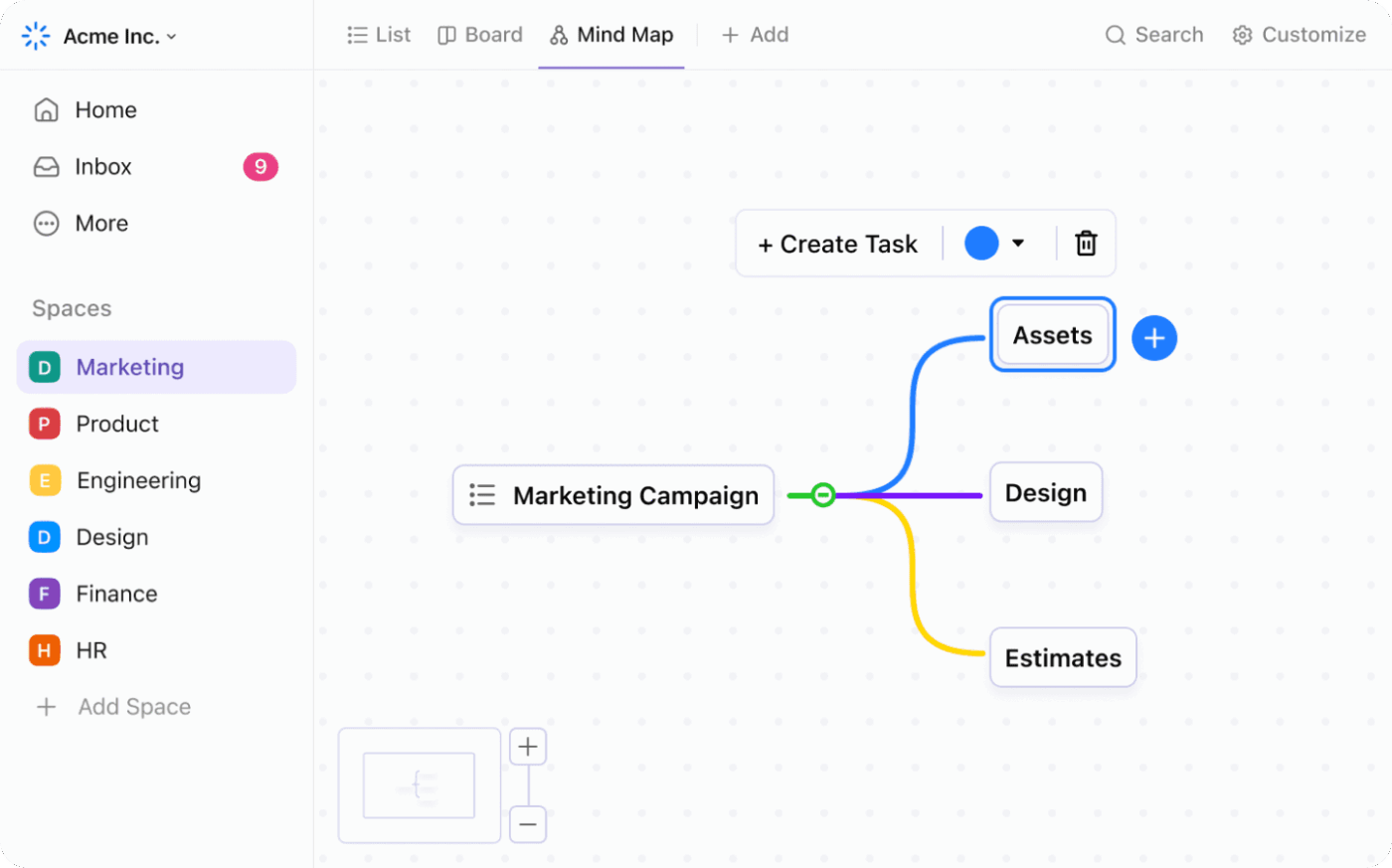
بمجرد أن تتكون لديك فكرة جيدة عن شكل سير عملك، قم بتنظيمه باستخدام:
- ملصقات لتمييز الأولويات أو لتخصيص الموارد
- حالات ClickUp المخصصة التي تناسب عمليتك بالضبط
- الترميز اللوني لتحديد حالة المهمة بنظرة واحدة (مثل اللون الأحمر للعناصر المحظورة)

⚡️أرشيف القوالب: هل تحتاج إلى رؤية أوسع للخطوط الزمنية؟ استخدم قالب مخطط جانت البسيط من ClickUp! هذا القالب هو حل جاهز للاستخدام لأي شخص يرغب في تخطيط المشاريع وجدولتها وتتبعها بصريًا بسهولة. هذا القالب مثالي للفرق من أي حجم، ويساعدك على تقسيم المهام وتحديد المواعيد النهائية وإدارة التبعيات في عرض خط زمني واحد واضح.
الخطوة 2: إنشاء مركز بصري مركزي
كل فريق يعمل بطريقة مختلفة — بعضها يزدهر في ظل الهيكلية، بينما يحتاج البعض الآخر إلى تدفق أكثر مرونة. حافظ على تماسك الجميع من خلال عرض العمل في صيغ تتوافق مع فريقك. والأهم من ذلك هو الحفاظ على مصدر مركزي واحد للحقيقة.
تتيح لك مساحات ClickUp إنشاء مساحات عمل مخصصة ومنظمة لكل مشروع، كل ذلك ضمن مساحة عمل مشتركة واحدة باستخدام المجلدات والقوائم. هذه هي اللبنات الأساسية الخاصة بك. ولكن لا يحب الجميع طريقة العرض الجدولية المفيدة هذه. قد يحتاج البعض إلى جدول زمني أو لوحة Kanban. وهنا يمكن أن تساعدك طرق العرض المخصصة من ClickUp. فهي تأتي مع 15 طريقة عرض مرئية مختلفة لسير عملك!
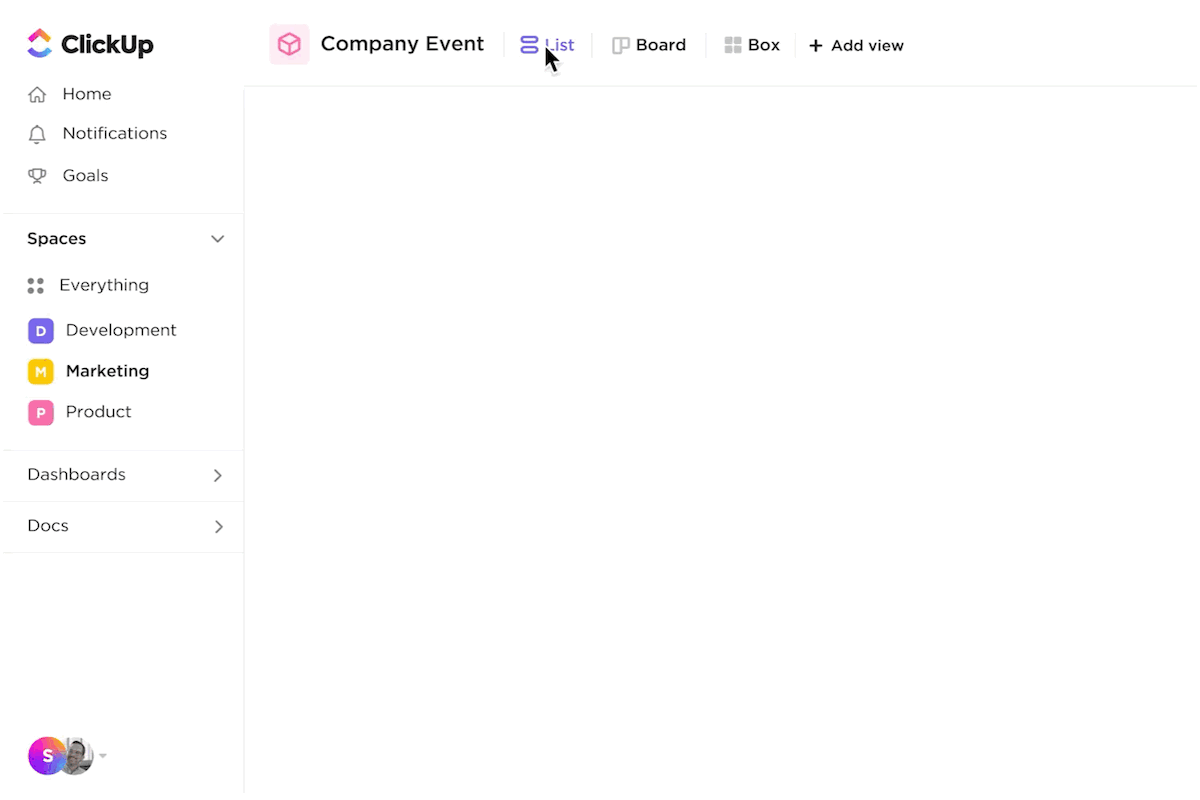
💟 مكافأة: يمكنك إضافة قالب ClickUp Kanban إلى مساحة عملك ومواءمة المهام لفريقك عبر مراحل مختلفة.
الخطوة 3: تتبع قدرات الفريق

تتعدى إدارة المشاريع الفعالة مجرد تتبع المهام. فهي تساعدك أنت وفريقك على ضمان الوضوح والمساءلة والتقدم. كيف يمكنك القيام بذلك؟
ابدأ بتقسيم المشاريع إلى مهام قابلة للتنفيذ، وتوزيع المسؤوليات، وتحديد مواعيد نهائية واضحة. استخدم الإشارات المرئية مثل الأولويات والتبعيات والمعالم البارزة للحفاظ على تماسك الجميع. راجع التقدم بانتظام وقم بتعديل الخطط حسب الحاجة للبقاء على المسار الصحيح.
يساعدك ClickUp في ذلك من خلال ميزات مثل:
- إنشاء المهام وتوزيعها: أنشئ المهام، ووزعها على أعضاء الفريق، وحدد مواعيد الاستحقاق والأولويات.
- التبعيات والعلاقات: اربط المهام التي تعتمد على بعضها البعض، بحيث يتضح ما يجب القيام به أولاً.
- الحقول المخصصة: تتبع البيانات الخاصة بالمشروع مثل الميزانيات أو الساعات المقدرة
- المعالم: قم بتمييز النتائج الرئيسية ونقاط التحقق
- القوالب: استخدم القوالب لأنواع المشاريع المتكررة لتوفير الوقت
- تتبع التقدم: استخدم قوائم المراجعة وأشرطة التقدم وتحديثات الحالة لمراقبة التقدم المحرز.
- التعاون: تعليقات مضمنة على المهام للحفاظ على سياق المناقشات
يعد نموذج لوحة معلومات إدارة المشاريع من ClickUp حلاً شاملاً للحفاظ على التنظيم والتوافق وتتبع قدرات الفريق.
الخطوة 4: إعداد عمليات أتمتة ذكية
هل سئمت من التحديثات المتكررة والخطوات المفقودة؟ تساعدك ClickUp Automations على تبسيط العمليات من خلال تشغيل الإجراءات بناءً على القواعد التي تحددها. الآن يمكن لفريقك التركيز أكثر على العمل وأقل على التحديث.

إليك ما يمكنك أتمتته:
- انقل المهام تلقائيًا إلى "المراجعة" عندما يتم وضع علامة عليها على أنها جاهزة للخطوة التالية
- ضع علامة على المهام على أنها عاجلة عندما تقترب المواعيد النهائية للحفاظ على أولويات واضحة
- أنشئ مهام متكررة تلقائيًا للاجتماعات اليومية أو عمليات التحقق الأسبوعية
- قم بتعيين المهام أو إرسال الإشعارات عند تغيير الحالة أو الأولوية
- قم بتحديث الحقول المخصصة أو انقل المهام بين القوائم أو المجلدات أو المساحات دون بذل أي جهد.
الخطوة 5: التعاون بفعالية

سواء كنت تخطط لمبادرة جديدة أو تشارك التحديثات أو تحل المشكلات فور ظهورها، فإن التعاون هو مفتاح نجاح المشروع. يجمع ClickUp بين التوثيق المنظم والتواصل السلس حتى يتمكن فريقك من العمل معًا دون أي تأخير.
باستخدام ClickUp Docs، يمكنك إنشاء مستندات حية مرتبطة مباشرة بسير عملك. تعاون وحرر وشارك في الوقت الفعلي — ليبقى الجميع على نفس الصفحة، بالمعنى الحرفي والمجازي. يمكن تنظيم المستندات في مجلدات وربطها بالمهام وإدارتها باستخدام أذونات مرنة، مما يسهل التحكم في الوصول والحفاظ على أمان المعلومات.
يتيح لك ذلك:
- قم بإنشاء وتحرير المستندات جنبًا إلى جنب مع مهامك وسير عملك، حتى لا تفقد السياق أبدًا.
- قم بتضمين لوحات المشاريع وخرائط الطريق وقوائم المهام مباشرة في مستنداتك للحصول على عرض موحد.
- اجعل التعليقات مرئية وقابلة للتنفيذ من خلال التعليقات في الوقت الفعلي والتحرير التعاوني
- نظم المستندات في مجلدات، واربطها بالمهام ذات الصلة، وقم بإدارة من يمكنه عرضها أو تحريرها ببضع نقرات فقط.
بالانتقال إلى التواصل السريع والمركّز، يحافظ ClickUp Chat على اتصال فريقك من خلال المراسلة الفورية المرتبطة بالمهام، كل ذلك ضمن نفس مساحة العمل. يمكنك بدء المحادثات دون الحاجة إلى تبديل الأدوات، ووضع علامات على زملائك في الفريق، وإرفاق الملفات، والربط مباشرة بالمهام أو المستندات.
استخدمها من أجل:
- ابدأ محادثات فورية لحل الأسئلة بسرعة، دون مغادرة سير عملك
- قم بتمييز زملائك في الفريق، ومشاركة الملفات، وربط المهام أو المستندات ذات الصلة لإجراء مناقشات غنية بالسياق.
- نظم المحادثات باستخدام سلاسل المحادثات، مع الحفاظ على وضوح الموضوعات وسهولة متابعتها
- ابقَ على اطلاع على جميع الأجهزة، حتى لا تفوتك أي رسالة أو قرار مهم
بفضل ميزات ClickUp التعاونية، يمكن لفريقك التواصل وتوثيق المعلومات والتنسيق، كل ذلك في مكان واحد، مما يدفع المشاريع إلى الأمام بوضوح وسرعة.
📮ClickUp Insight: 11٪ من المشاركين في الاستطلاع يستخدمون الذكاء الاصطناعي بشكل أساسي في العصف الذهني وتوليد الأفكار. ولكن ماذا يحدث لهذه الأفكار الرائعة بعد ذلك؟ هنا تحتاج إلى لوحة بيضاء مدعومة بالذكاء الاصطناعي، مثل ClickUp Whiteboards، التي تساعدك على تحويل الأفكار من جلسة العصف الذهني إلى مهام على الفور. وإذا لم تتمكن من شرح مفهوم ما، فما عليك سوى أن تطلب من مولد الصور بالذكاء الاصطناعي إنشاء صورة بناءً على موجهاتك. إنها التطبيق الشامل للعمل الذي يمكّنك من ابتكار الأفكار وتصورها وتنفيذها بشكل أسرع!
أفضل برامج إدارة المشاريع المرئية
تحول برامج إدارة المشاريع المرئية سير العمل المعقد إلى صور مرئية واضحة وبديهية، مما يساعد الفرق على رؤية الصورة الكاملة وتتبع التقدم والتعاون بشكل أفضل.
فيما يلي خمس أدوات إدارة المشاريع المرئية الأعلى تقييمًا، بعد ClickUp بالطبع:
1. Trello مثالي لتتبع المشاريع البسيطة على غرار Kanban، يستخدم Trello البطاقات واللوحات لتصور المهام. إنه مثالي للفرق الصغيرة وخطط التسويق والمشاريع الشخصية. تشمل الميزات قوائم المراجعة وتواريخ الاستحقاق وPower-Ups (التكاملات) ونقل المهام بالسحب والإفلات.
2. Monday. comيشتهر موقع Monday.com بواجهته الملونة وتعدد استخداماته، ويوفر عدة طرق للعرض، مثل Kanban والجدول الزمني والتقويم والرسوم البيانية. وهو يدعم تبعيات المهام والأتمتة والتكامل ولوحات معلومات الفريق، مما يجعله خيارًا قويًا لكل من الشركات الناشئة والمؤسسات.
3. Asana تجمع Asana بين الوضوح البصري وميزات إدارة المهام القوية. يمكن للفرق التبديل بين عرض القوائم واللوحات والتقويم والجدول الزمني، وتحديد المعالم، وتتبع التبعيات، وإدارة أحمال العمل — وهي ميزة رائعة للتعاون بين الأقسام المختلفة.
4. Notion على الرغم من أن Notion هي في الأساس أداة توثيق، إلا أنها تطورت لتصبح أداة قوية لإدارة المشاريع بصريًا مع لوحات السحب والإفلات والجداول الزمنية وعروض قواعد البيانات. تتيح لك مرونتها إنشاء سير عمل مخصص للغاية مع مواقع ويكي وملاحظات وتتبع المشاريع، كل ذلك في مكان واحد.
5. Wrikeصُمم Wrike للفرق التي تعمل في بيئات عمل معقدة، ويتميز بمخططات جانت وإدارة عبء العمل وتتبع الوقت وأدوات إعداد التقارير المتقدمة. ويجعله تدفق الأنشطة في الوقت الفعلي ولوحات المعلومات الديناميكية مفيدًا بشكل خاص للوكالات وفرق الخدمات المهنية.
يقتبس أوراي سيفتليكليوغلو، مصمم Ui + UX في Enhance Ventures ومستخدم ClickUp، ما يلي:
بصفتي محترفًا، عملت في فرق تنتج مشاريع رقمية لمدة 20 عامًا تقريبًا. لطالما شعرت بعدم الارتياح تجاه واجهات المستخدم المملة المصممة من قبل المهندسين وتجارب المستخدم لمنصات مثل Jira و Trello التي كنت أستخدمها من قبل. علمت ClickUp الصناعة أهمية "العامل البشري". وأصبحت أفضل مثال على استخدام القوة البناءة والمفيدة للتصميم.
بصفتي محترفًا، عملت في فرق تنتج مشاريع رقمية لمدة 20 عامًا تقريبًا. لطالما شعرت بعدم الارتياح تجاه واجهات المستخدم المملة المصممة من قبل المهندسين وتجارب المستخدم لمنصات مثل Jira و Trello التي كنت أستخدمها من قبل. علمت ClickUp الصناعة أهمية "العامل البشري". وأصبحت أفضل مثال على استخدام القوة البناءة والمفيدة للتصميم.
التحديات الشائعة في إدارة المشاريع البصرية (وكيفية حلها)
تسهل إدارة المشاريع البصرية تتبع التقدم المحرز وتوزيع المهام والحفاظ على التوافق، ولكنها لا تخلو من التحديات. عند عدم استخدامها بشكل صحيح، يمكن أن تؤدي حتى أفضل الأدوات إلى الارتباك والفوضى وتجاوز المواعيد النهائية.
1. المشكلة: الحمل البصري الزائد
قد يؤدي وجود الكثير من الألوان والأعمدة والعلامات والأدوات المصغرة إلى تحويل لوحة مفيدة إلى فوضى عارمة.
الحل: اجعل الأمر بسيطًا. التزم بنظام ترميز لوني متسق وقلل الحقول المخصصة إلى ما هو ضروري. استخدم المرشحات والأقسام القابلة للطي لعرض ما هو ذو صلة بكل عضو في الفريق فقط.
2. المشكلة: عدم وجود تحديثات في الوقت الفعلي
عندما ينسى أعضاء الفريق تحديث حالة المهام، تصبح لوحتك قديمة بسرعة.
الحل: استخدم الأتمتة لنقل المهام أو إرسال التذكيرات أو تحديث الحقول بناءً على المحفزات. شجع على عادة التحديث السريع في نهاية اليوم للحفاظ على الأمور محدثة دون إضافة اجتماعات إضافية.
3. المشكلة: عدم وضوح الملكية
إذا لم يكن من الواضح من المسؤول عن ماذا، فإن المهام ستفشل.
الحل:عيّن مالكًا واحدًا لكل مهمة. يجب أن تظهر الأدوات المرئية بوضوح المكلف بالمهمة والموعد النهائي والأولوية، بحيث لا يكون هناك أي شك في المساءلة.
4. المشكلة: لا توجد طريقة واحدة تناسب الجميع
يفضل بعض أعضاء الفريق استخدام Kanban، بينما يحتاج آخرون إلى جداول زمنية أو تقويمات.
الحل: اختر الأدوات التي توفر طرق عرض متعددة وتتيح للأفراد اختيار الطريقة التي يرغبون في رؤية عملهم بها. هذا يجعل الجميع يشعرون بالراحة دون المساس بالتنسيق.
5. المشكلة: الاعتماد المفرط على العناصر المرئية دون سياق
قد يكون الرسم البياني الدائري أو اللوحة البيانية التي لا تحتوي على معلومات داعمة مضللة.
الحل: اربط اللوحات المرئية بالسياق المكتوب — الأوصاف أو التعليقات أو المستندات المرتبطة. يضيف ذلك الوضوح، خاصة عند التعاون بين الفرق أو المناطق الزمنية.
اجعل مشاريعك تبرز مع ClickUp
لا داعي لأن تسبب لك إدارة تعقيدات المشاريع صداعًا.
يساعد النظام البصري القوي فريقك على اكتشاف العقبات، وتتبع التقدم المحرز، واتخاذ قرارات مستنيرة دون الغرق في جداول البيانات.
مع أدوات ClickUp المرئية، ستحصل على هذا النوع من الوضوح بالضبط.
لا مزيد من اجتماعات تحديث الحالة التي كان من الممكن أن تكون لوحة معلومات. لا مزيد من "الأسئلة السريعة" التي تقاطع سير عملك. فقط صور واضحة ونقية تبقي الجميع على اتساق وتدفعهم للمضي قدمًا.
جرب ClickUp مجانًا اليوم وشاهد مشاريعك تتحقق.



